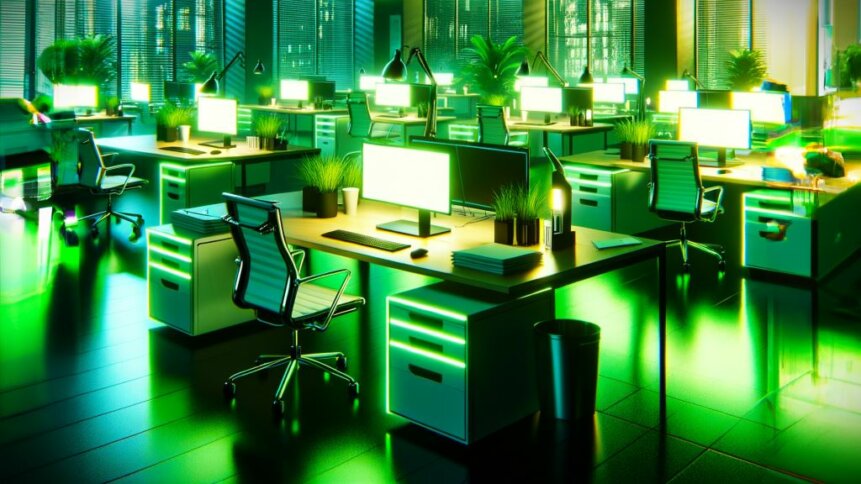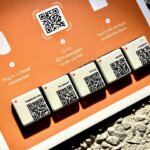Going green – more to come from solid-state lighting

|
Getting your Trinity Audio player ready...
|
Much has been said about the role of LEDs in creating energy-efficient lighting. And, without a doubt, it’s a technology worth celebrating. But the story isn’t over yet, as researchers in the US believe that they’ve found a pathway to unlock even more energy-efficient LED lighting by plugging the so-called green gap.
The white LED bulbs that are all around us today are mostly based on blue light emitters covered with a layer of yellow (or sometimes separate green and red) phosphor. The photoluminescent coating absorbs some of the blue-LED emission and reemits yellow (or green and red) light to produce a white glow when the colors combine.
LED lighting has been credited with saving vast amounts of energy as solid-state emitters convert more energy into light compared with incandescent bulbs, which radiate large amounts of heat. The payback time for businesses that switch from using incandescent bulbs to energy-efficient LED lighting can be as little as 12 months or less.
However, the phosphor-based color mixing process, known as down-conversion, has its downsides. Firstly, there’s an energy penalty involved in turning high-energy blue light into lower-energy emission at longer wavelengths – in this case, yellow light. Regular white light LEDs emit around seven times more heat than light, according to reports.
The good news is that there’s a way to side-step these losses by using individual red, green, and blue LED chips to produce energy-efficient lighting.
Solid state white lighting featuring blue LEDs and phosphor coatings is said to have a theoretical luminous efficiency of 255 lumens/watt compared with 408 lumens/watt for devices based on individual color mixed elements. For comparison, incandescent bulbs – even halogen-based lamps – top out at around 20-25 lumens/watt, in practice.
There are other reasons to avoid using phosphor coatings, as they can degrade over time and add to the packaging costs of the device. And, having mentioned these drawbacks, it’s only right to point out that color-mixed LEDs have their own issues as well – principally concerning the emission of green light, which is why the latest news has raised hopes amongst developers.
.@bruce_munro’s ‘Field of Lights’ puts an otherworldly twist on the usual garden landscape, illuminating @nycgov with 18,750 #LED spheres! 🌼🌌@corcorangroup has more on the galaxy-inspired light show: https://t.co/jeOAexeJ1F pic.twitter.com/4GGUMB7v8E
— Lumileds (@lumileds) January 22, 2024
Typically, pushing more current through green LEDs – to make them brighter – produces an effect referred to as LED droop, which dims performance. But the researchers, based at the Innovative COmpound semiconductoR LABoratory (ICORLAB) in the US, believe that they’ve found a way to grow the necessary compound semiconductor layer with fewer defects to avoid such a scenario.
Looking ahead, they believe that the development of higher-performance green LEDs could unlock a 3x boost in the efficiency of white light LEDs compared with devices that are available today.
Don’t forget to turn off the lights
Innovations in solid-state lighting are welcome, helping to reduce energy costs at facilities. However, building management systems have an important role to play too in making offices and other business premises cheaper to run.
Using motion sensors to turn lights off when rooms and corridors are empty can further reduce the amount of energy consumed by buildings. What’s more, collecting occupancy sensor data can help building managers to determine how often different parts of the facility are being used.
Analysts credit LED lighting as saving millions of tons of CO2 emissions compared with the continued use of incandescent bulbs and fluorescent tubes. However, the challenge is being able to raise the efficiency of solid-state devices to keep up with the increased demand for lighting globally.
READ NEXT

Smart tech for the 15-minute city
The International Energy Agency (IEA) reports that despite the falling carbon intensity of electricity, CO2 emissions from lighting rose slightly in 2022, which makes breakthroughs in green LEDs all the more important.
“To stay on track with the Net Zero Scenario, all lighting sales need to be LED technology by 2025, with higher efficacy levels by 2030,” writes the IEA in its analysis of lighting use in buildings. “Although the trend towards LED technology is positive, governments need to continue their efforts to realise this goal.”
Global electricity consumption in lighting needs to fall to 1041.45 TWh for services and 325.43 TWh for residential by 2030, which represents a reduction of around 20 – 30% from current levels.








